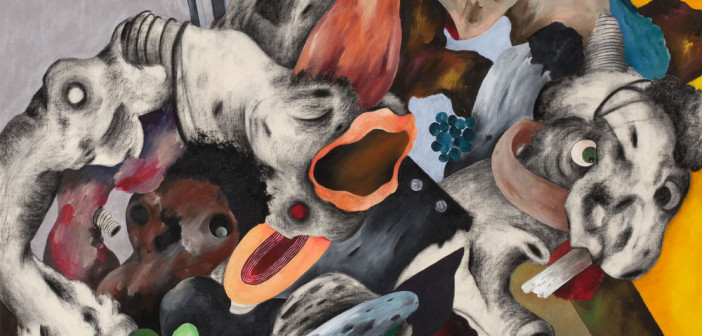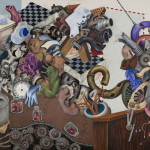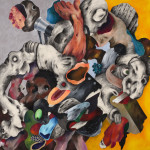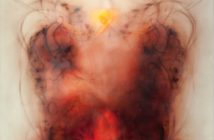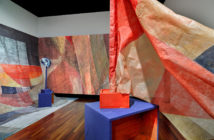Charcoal is made by burning, so an artist might use slivers of charred ruins to draw with. In the midst of all the color, it is the prominence of this dark medium from out of the flames that resonates most strongly in these works by Ahmed Alsoudani.
For all their scale (the largest is 72 x 108 in) these works document a grand history of pain in very small spaces. Inevitably, none of these pictures have titles. The dreadful realities which they draw from are unnamable, though familiar enough to those who have suffered what is now called their "collateral damage." They read as fragments of a continuous tapestry, parts of a single shattered narrative with a repetition of motifs — like Tolstoy’s happy families, all wars are the same in their details, if not their dimensions.
There is no clear distinction between assembly and disassembly in the mosaics of debris that each painting contains. These are portraits of mutilation, with mechanical and organic fragments laced together. Here are corpses on their journey to skeleton alongside prosthetics for the soul with a miniature but ominous cluster of wrath’s grapes in a corner.
| The blurring of detail is a consequence of war’s fog. |
It unexpectedly recalls the Willem de Kooning drawing erased by Robert Rauschenberg. With only traces of the original remaining, Raucschenberg’s erasure was an act of elemental destruction. But the more immediate tradition that these works depend on are the apocalyptic fantasies of the 15th century painter Hieronymus Bosch. Here is the same jewelry of violence with ornamental fragments of shrapnel, toothed and marvelous.
In another one of these paintings, the lost identities of body parts is a central subject, depicted in a confusion of what might be either animal or human. Here is the disembodied agony of Gericault’s morgue studies, a shattered mirror with no visible reflection, and duct work out of Terry Gilliam’s Brazil, complex and useless. The backdrop to the composition is a frame of steel bars, as if all the world had become the immense prison that Hamlet envisioned.
One painting catalogues surveillance and interrogation, both anatomical and electronic, accompanied by the torturer’s badge of rank and an homage to the technical precedent of nails for crucifixion. In another image, the bureaucrat's dice echo Golgotha once again, alongside a suggestion of the deformed Joseph Merrick, that 19th century "Elephant Man" with its pointed reminder of what’s lost beneath the skin.
Anatomical specimens in their conventional glass jars are defiantly legible references in the industrial laboratory of a painting where the machinery of Chaplin’s Modern Times has been put entirely in the service of malevolence, turned from producing widgets to weapons. Around the industrial landscape of this deformed Oz are scattered the remains of the Tin Woodsman and Scarecrow. The scattered scraps of colorful fabrics serve as the only memorials of a recent suicide bombing or the 1991 immolation of hundreds of civilians inside a shelter in the Amiriyah neighborhood of Baghdad. Game boards without pieces or players were the war makers’ toys, but the playing is over and the damage done. And what new destruction will hatch from these unbroken eggs in the lower center of the canvas?
In the United States, the memory of the violence that was the Iraq War is already at a distance, silenced and indistinct. But there are Iraqi artists whose work stands as a rebuke to our embrace of forgetfulness: Qasum Sabti, with his collages from fragments of burned books found in the ruins of a library bombed early in the Iraq War, or Abdel-Karim Khalil who carved a small marble figure in a purely Classical style, except with a prisoner’s hood pulled over its head. Alsoudani is another. Exile is no protection for an artist who records as clearly as he does what happened to the world he has left behind.
- Ahmed Alsoudani, Untitled, Charcoal and Acrylic on Canvas, 2012.
- Ahmed Alsoudani, Untitled, Charcoal and Acrylic on Canvas, 2011.

